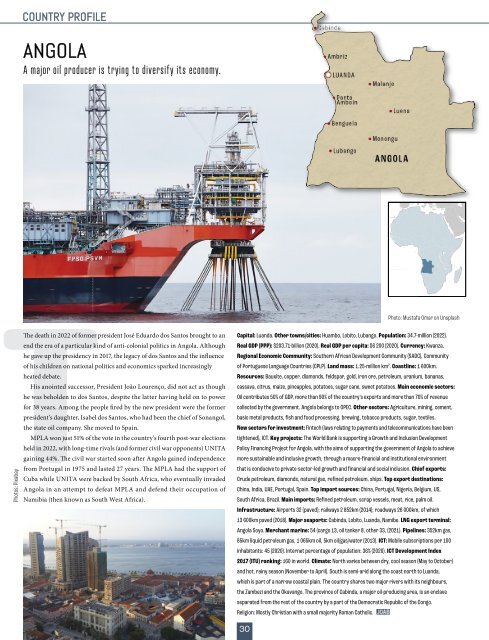Journal of African Business Issue 5
Welcome to The Journal of African Business - a unique guide to business and investment in Africa. Every edition carries editorial copy covering the following general topics, with a wide range of subjects within each broader economic sector: energy; mining and exploration; trade; finance; technology and tourism. In addition to this, special features on topical matters will be published periodically, along with country profiles. In this edition, the in-depth interview with Aggreko Head of Sales, Southern East Africa, Max Schiff, makes clear how important captive power is for the future viability of a wide variety of projects in Africa. As Schiff points out, the extractives industry has long been a leader in the application of captive power, given the remote location of many mining operations, but the flexibility and ESG advantages that captive power using renewables offers is making it an ever-more attractive option for many different sectors.
Welcome to The Journal of African Business - a unique guide to business and investment in Africa.
Every edition carries editorial copy covering the following general topics, with a wide range of subjects within each broader economic sector: energy; mining and exploration; trade; finance; technology and tourism.
In addition to this, special features on topical matters will be published periodically, along with country profiles.
In this edition, the in-depth interview with Aggreko Head of Sales, Southern East Africa, Max Schiff, makes clear how important captive power is for the future viability of a wide variety of projects in Africa. As Schiff points out, the extractives industry has long been a leader in the application of captive power, given the remote location of many mining operations, but the flexibility and ESG advantages that captive power using renewables offers is making it an ever-more attractive option for many different sectors.
Create successful ePaper yourself
Turn your PDF publications into a flip-book with our unique Google optimized e-Paper software.
COUNTRY PROFILE<br />
ANGOLA<br />
A major oil producer is trying to diversify its economy.<br />
TThe death in 2022 <strong>of</strong> former president José Eduardo dos Santos brought to an<br />
Photos: Pixabay<br />
end the era <strong>of</strong> a particular kind <strong>of</strong> anti-colonial politics in Angola. Although<br />
he gave up the presidency in 2017, the legacy <strong>of</strong> dos Santos and the influence<br />
<strong>of</strong> his children on national politics and economics sparked increasingly<br />
heated debate.<br />
His anointed successor, President João Lourenço, did not act as though<br />
he was beholden to dos Santos, despite the latter having held on to power<br />
for 38 years. Among the people fired by the new president were the former<br />
president’s daughter, Isabel dos Santos, who had been the chief <strong>of</strong> Sonangol,<br />
the state oil company. She moved to Spain.<br />
MPLA won just 51% <strong>of</strong> the vote in the country’s fourth post-war elections<br />
held in 2022, with long-time rivals (and former civil war opponents) UNITA<br />
gaining 44%. The civil war started soon after Angola gained independence<br />
from Portugal in 1975 and lasted 27 years. The MPLA had the support <strong>of</strong><br />
Cuba while UNITA were backed by South Africa, who eventually invaded<br />
Angola in an attempt to defeat MPLA and defend their occupation <strong>of</strong><br />
Namibia (then known as South West Africa).<br />
Photo: Mustafa Omar on Unsplash<br />
Capital: Luanda. Other towns/cities: Huambo, Lobito, Lubango. Population: 34.7-million (2022).<br />
Real GDP (PPP): $203.71-billion (2020). Real GDP per capita: $6 200 (2020). Currency: Kwanza.<br />
Regional Economic Community: Southern <strong>African</strong> Development Community (SADC), Community<br />
<strong>of</strong> Portuguese Language Countries (CPLP). Land mass: 1.25-million km 2 . Coastline: 1 600km.<br />
Resources: Bauxite, copper, diamonds, feldspar, gold, iron ore, petroleum, uranium, bananas,<br />
cassava, citrus, maize, pineapples, potatoes, sugar cane, sweet potatoes. Main economic sectors:<br />
Oil contributes 50% <strong>of</strong> GDP, more than 90% <strong>of</strong> the country’s exports and more than 70% <strong>of</strong> revenue<br />
collected by the government. Angola belongs to OPEC. Other sectors: Agriculture, mining, cement,<br />
basic metal products, fish and food processing, brewing, tobacco products, sugar, textiles.<br />
New sectors for investment: Fintech (laws relating to payments and telecommunications have been<br />
tightened), ICT. Key projects: The World Bank is supporting a Growth and Inclusion Development<br />
Policy Financing Project for Angola, with the aims <strong>of</strong> supporting the government <strong>of</strong> Angola to achieve<br />
more sustainable and inclusive growth, through a macro-financial and institutional environment<br />
that is conducive to private-sector-led growth and financial and social inclusion. Chief exports:<br />
Crude petroleum, diamonds, natural gas, refined petroleum, ships. Top export destinations:<br />
China, India, UAE, Portugal, Spain. Top import sources: China, Portugal, Nigeria, Belgium, US,<br />
South Africa, Brazil. Main imports: Refined petroleum, scrap vessels, meat, rice, palm oil.<br />
Infrastructure: Airports 32 (paved); railways 2 852km (2014); roadways 26 000km, <strong>of</strong> which<br />
13 600km paved (2018). Major seaports: Cabinda, Lobito, Luanda, Namibe. LNG export terminal:<br />
Angola Soyo. Merchant marine: 54 (cargo 13, oil tanker 8, other 33, (2021). Pipelines: 352km gas,<br />
85km liquid petroleum gas, 1 065km oil, 5km oil/gas/water (2013). ICT: Mobile subscriptions per 100<br />
inhabitants: 45 (2020). Internet percentage <strong>of</strong> population: 36% (2020). ICT Development Index<br />
2017 (ITU) ranking: 160 in world. Climate: North varies between dry, cool season (May to October)<br />
and hot, rainy season (November to April). South is semi-arid along the coast north to Luanda,<br />
which is part <strong>of</strong> a narrow coastal plain. The country shares two major rivers with its neighbours,<br />
the Zambezi and the Okavango. The province <strong>of</strong> Cabinda, a major oil-producing area, is an enclave<br />
separated from the rest <strong>of</strong> the country by a part <strong>of</strong> the Democratic Republic <strong>of</strong> the Congo.<br />
Religion: Mostly Christian with a small majority Roman Catholic.<br />
30<br />
M


















